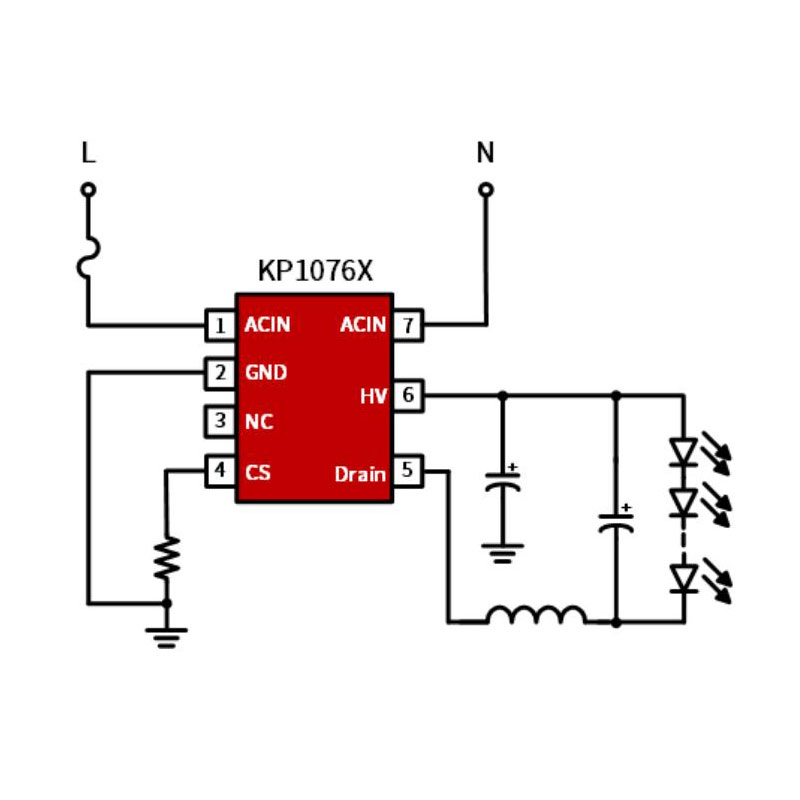How Does Integrated EMI Filter in ACDC Constant Current Chip Simplify Power Supply Design?
2025-07-01
How can ACDC constant current chips break through traditional limitations with an "invisible shield"
In the laboratory of Guangming Science City in Shenzhen, engineers from Huqin Technology are cheering around the newly rolled ACDC constant current chip - this chip, which is only the size of a fingernail, has suppressed conducted interference to 58% of the international standard limit without any external filtering components. This means that the "filter component stuffing war" that has lasted for three decades in the field of power supply design may come to an end.
Five years ago, when we designed an industrial lighting power supply for an international brand, 17 components were used in the light EMI filtering section. Lin Hao, the chief engineer of Huqin, held up the new and old design drawings and said, "Now with our integrated solution, we can also achieve the EN55015 Class B standard. The number of components has been reduced from 23 to 6, and the PCB area has been shrunk by 71%." This disruptive change stems from the team's re-deconstruction of electromagnetic compatibility technology.
While DCDC constant current chips are still fiercely competing in the "discrete filtering" race, Huqin's ACDC solution has already opened up a new dimension. In the comparative test, a certain communication base station power supply using the traditional DCDC solution requires a 4-layer PCB layout for the filter circuit, while Huqin's ACDC chip achieves the same performance with just a single board. The key lies in that we have "dissolved" the filtering function into the texture of the chip. Lin Hao gently tapped the microscopic projector. "Look at these interwoven metal grids. They form a three-dimensional electromagnetic absorber, just like putting an invisible bulletproof vest on the chip."
This technological leap demonstrates its advantages in wide-voltage scenarios. When the input voltage jumps from 90V to 264V, Huqin's ACDC chip can dynamically adjust the internal electromagnetic structure to keep the noise attenuation rate consistently above 42dB. However, when the voltage of a certain competing product's DCDC solution undergoes a sudden change, the filtering effect will decline by 15dB. This is like teaching the chip "metamorphosis". Test engineer Xiao Zhang pointed at the spectrum analyzer and said, "Our chip can reconstruct the electromagnetic topology in real time based on the interference frequency. This kind of intelligent response is something that discrete solutions can never catch up with."

In Huqin's reliability laboratory, a device undergoing 4,000 hours of continuous testing has revealed more secrets. When the ambient temperature rises from 25℃ to 85℃, the filtering performance of the ACDC chip only decreases by 0.8dB, while the traditional scheme attenuates by 6.3dB under the same conditions. This is attributed to our original "temperature compensation electromagnetic matrix". Lin Hao showed the chip profile model, "Around each switch tube, we embedded nanocrystalline magnetic materials. They can adjust their magnetic permeability like chameleons with temperature, always maintaining the best filtering state."
For export products that require global certification, Huqin's integrated solution demonstrates astonishing adaptability. After A certain medical equipment manufacturer adopted this technology, its X-ray photoelectric power supply passed the certifications of seven countries including FCC Part 18 and VCCI Class A at one time. What surprises us the most is the freedom of design. The hardware director of the manufacturer said, "Previously, 20mm of filtering space had to be reserved. Now, the routing can be arranged freely. Our engineers can finally design PCBS in accordance with aesthetic principles."
In Huqin's digital exhibition hall, engineers demonstrated the intelligent configuration function of the chip on the spot. By scanning the QR code of the chip with a mobile phone, the system automatically generates parameter packages for different application scenarios. This is equivalent to providing each power supply designer with an AI assistant. Product Manager Chen Wei swiped through the configuration interface. "A small and medium-sized customer developed an LED driver power supply using our solution. It only took 22 days from prototype to mass production, while it used to take at least four months."
In Huqin's digital exhibition hall, engineers demonstrated the intelligent configuration function of the chip on the spot. By scanning the QR code of the chip with a mobile phone, the system automatically generates parameter packages for different application scenarios. This is equivalent to providing each power supply designer with an AI assistant. Product Manager Chen Wei swiped through the configuration interface. "A small and medium-sized customer developed an LED driver power supply using our solution. It only took 22 days from prototype to mass production, while it used to take at least four months."
Standing in front of the honor wall covered with patent certificates, Lin Hao opened a yellowed notebook, which contained the design parameters of the first-generation power chip that he had recorded twenty years ago. At that time, we couldn't even afford EMI simulation software and had to calculate the inductance value by hand. He gently closed the notebook. "Now our chip can automatically compensate for the parasitic effects caused by PCB layout and also optimize the filtering parameters according to the load changes." This is the romance of Chinese chip engineers - using the most cutting-edge technology to solve the most fundamental engineering problems.



